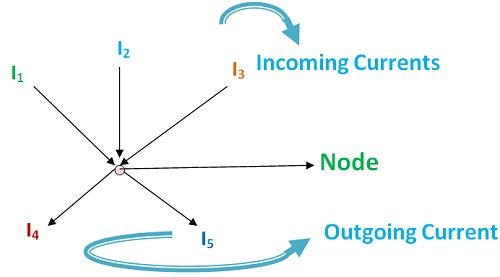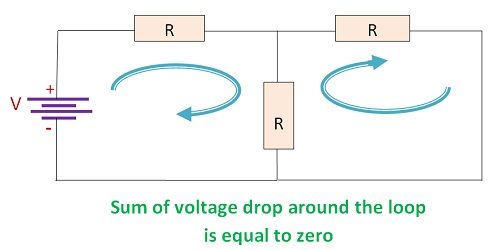Have you ever thought why we need a Kirchhoff’s Circuit law? Your answer might be that Kirchhoff’s Circuit law is used to find current and voltage in electronic circuits but then what about Ohm’s law? Because Ohm’s law can also be used to determine current and voltage in electronic circuits, but still we need Kirchhoff’s circuit law, why is it so?
The answer to this question is, in the case of complicated circuits such as Bridge and T-networks we cannot find current and voltage circulating in circuit simply by using Ohm’s law.
The origin of Kirchhoff’s Circuit law lies in mid of 19th Century, i.e. in 1845 a famous Physicist from Germany Gustav Kirchhoff used the basic principle, “Energy can neither be created nor be destroyed” and came up with rules based upon conservation of charge and energy.
The two laws given by Gustav Kirchhoff were Kirchhoff’s Current Law (KCL) and Kirchhoff’s Voltage Law (KVL), KCL deals with the current flowing in a closed circuit while KVL deals with voltage sources present in a closed circuit.
Let us discuss these two laws in detail:-
Kirchhoff’s Current Law/Kirchhoff’s First Law (KCL)
According to this law ” total charge or current entering the circuit is equal to total charge or current leaving the circuit”. The fundamental principle on which this law works is Conservation of Charge i.e. “ Charge can neither be created nor be destroyed”.

How KCL is applied in Electronics Circuits?
Mathematically, it can be understood as IE +IL=0, where IE is current entering the circuit and IL is the current leaving the circuit and current entering the circuit will be taken as positive and current leaving the circuit will be taken as negative.
Sign Convention: IE= +ve and IL=-ve thus above equation can be written as IE + (-IL) =0
Thus, it can be concluded from above equation that current entering the node and leaving the node will be equal. Suppose if there are two or more incoming current in the circuit and two or more outgoing current in the circuit then all the current components entering will be equal to all the current components leaving the circuit.
Let’s take example of electronic circuit in which I1, I2, I3 are incoming and outgoing current are I4, I5 thus, according to KCL, I1+ I2+ I3 = I4 + I5
Terminologies involved with Kirchhoff’s Circuit law: Several terms such as node or junction, loop, mesh, path are used while using KCL and KVL. Let’s put a light on these terms.
a. Node or junction: It is represented in the circuit by a single dot. It is the point in a circuit where different current paths meet. All the current components meet at a particular node or junction.
b. Branch: It is that component of an electronic circuit which consists of resistors, capacitors, inductors. And these are connected between two nodes. In short, we can say two nodes when joined; it forms a branch.
c. Loop: Loop is the closed path in a circuit in which electronic device such as resistor, capacitor is traversed only once.
d. Mesh: A mesh is a loop which has no loops or components inside it.
Kirchhoff’s Voltage Law/ Kirchhoff’s Second Law (KVL)
According to KVL, the summation of potential difference around the closed network is always zero. The fundamental principle behind KVL is conservation of energy, or more precisely it deals with conservation of electric power.

Sign Convention: When the direction of current flowing in the loop is same as the direction in which we are traversing, the potential drop across the elements will be taken as negative. If the direction of current flowing in the loop is opposite to the traversing direction, then the potential drop across the electronic components will be taken as positive.
In the traversing direction if we encounter the negative terminal of the battery first i.e. the battery is generating current in the direction of our traversing then the battery potential is taken as positive. If during our traversing we encounter the positive terminal of battery first i.e. the battery is generating current in opposite direction of our traversing the battery potential is taken as negative.
Points to remember
1. Electronic components are considered to be connected in series if the magnitude of the current flowing through them is same.
2. Electronic components are considered to be connected in parallel if they have the same voltage applied across them.
Applications of Kirchhoff’s Circuit law
1. It is used for DC Circuit analysis.
2. It can be applied to any DC circuit and low-frequency AC circuits regardless of its composition and architecture.
3. It can be used for AC Circuits at frequencies. In such circuits, the wavelengths of electromagnetic radiations are very large as compared to the size of the circuit.
Limitations of Kirchhoff’s Circuit Law
1. Kirchhoff’s Circuit law is based on lumped element model. Thus, if any electronic circuit does not follow lumped element model, then Kirchhoff’s law cannot be applied to them.
2. This law is not applicable to high-frequency AC Circuits. This is because this law is dependent on the principle that current flows only in conductors. Moreover, it enters at one ends and leaves from another end. But this is not so in the case of the high-frequency circuit because of Parasitic Capacitance.
How KVL is applied in Electronic Circuits?
If we start traversing from a point in a loop and summing up potential differences across various electronic components in a circuit, the summation will be equivalent to zero.
Leave a Reply